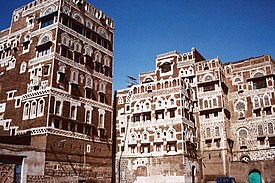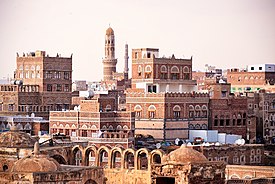
Back Shan'a' ACE Сана ADY Sanaa Afrikaans ሳና Amharic Sana AN صنعاء Arabic صنعا ARZ Sana'a AST Səna Azerbaijani صنعا AZB
Sanaa
صَنْعَاء Ṣanʿāʾ 𐩮𐩬𐩲𐩥 | |
|---|---|
Clockwise from top: Sanaʽa skyline, the Old City, National Museum of Yemen, Gate of Yemen, Al Saleh Mosque | |
| Nickname: ʾAmānat Al-ʿĀṣimah (أَمَانَة ٱلْعَاصِمَة) | |
 Map of the city | |
| Coordinates: 15°20′54″N 44°12′23″E / 15.34833°N 44.20639°E | |
| Country | |
| Administrative division | Capital's secretariat |
| Control | |
| Government | |
| • Type | Local |
| Area | |
| • Total | 126 km2 (49 sq mi) |
| Elevation | 2,250 m (7,380 ft) |
| Population (2017)[1] | |
| • Total | 2,545,000 |
| • Estimate (2023)[2] | 3,292,497 |
| Demonym(s) | Sanaani, San'ani |
| Time zone | UTC+3 (AST) |
Sanaa (Arabic: صَنْعَاء, Ṣanʿāʾ [sˤɑnʕaːʔ], Yemeni Arabic: [ˈsˤɑnʕɑ]; Old South Arabian: 𐩮𐩬𐩲𐩥 Ṣnʿw), also spelled Sana'a and Sana, is the capital and largest city of Yemen and the capital of the Sanaa Governorate. The city is not part of the Governorate but forms the separate administrative district of ʾAmānat al-ʿĀṣimah (أَمَانَة ٱلْعَاصِمَة). According to the Yemeni constitution, Sanaa is the capital of the country,[3] although the seat of the Yemeni government moved to Aden, the former capital of South Yemen, in the aftermath of the Houthi occupation. Aden was declared as the temporary capital by then-president Abdrabbuh Mansur Hadi in March 2015.[4]
At an elevation of 2,300 metres (7,500 ft),[5] Sanaa is one of the highest capital cities in the world[citation needed] and is next to the Sarawat Mountains of Jabal An-Nabi Shu'ayb and Jabal Tiyal, considered to be the highest mountains in the Arabian Peninsula and one of the highest in the region. Sanaa has a population of approximately 3,292,497 (2023), making it Yemen's largest city.[6] As of 2020, the greater Sanaa urban area makes up about 10% of Yemen's total population.[7]
The Old City of Sanaa, a UNESCO World Heritage Site, has a distinctive architectural character, most notably expressed in its multi-story buildings decorated with geometric patterns. In the conflict that raged in 2015, explosives hit UNESCO sites in the old city.[8][9] The Al Saleh Mosque, the largest in Sanaa, is located in the southern outskirts of the city.
Sanaa has been facing a severe water crisis,[10] with water being drawn from its aquifer three times faster than it is replenished. The city is predicted to run completely out of water by around 2030, making it the first national capital in the world to do so. Access to drinking water is very limited in Sanaa, and there are problems with water quality.[11]
- ^ Central Statistics Organization. "Yemen Statistical Yearbook 2017". Archived from the original on 20 January 2021. Retrieved 31 August 2020.
- ^ "Sanaa Population 2024".
- ^ "Yemen's embattled president declares southern base temporary capital". DPA International. 21 March 2015. Archived from the original on 11 July 2015.
- ^ "Yemen's President Hadi declares new 'temporary capital'". Deutsche Welle. 21 March 2015. Archived from the original on 5 June 2015. Retrieved 21 March 2015.
- ^ McLaughlin, Daniel (2008). "3: Sanaʽa". Yemen. Bradt Travel Guides. p. 67. ISBN 978-1-8416-2212-5. Archived from the original on 14 February 2023. Retrieved 26 September 2020.
- ^ "Sanaa Population 2023". worldpopulationreview.com. Retrieved 14 August 2023.
- ^ Sana'a City Profile (PDF). United Nations Human Settlements Programme in Yemen. 2020. Archived (PDF) from the original on 14 April 2021. Retrieved 27 February 2021.
- ^ Young, T. Luke. "Conservation of the Old Walled City of Sanaʽa Republic of Yemen". MIT. Archived from the original on 3 August 2018. Retrieved 7 April 2011.
- ^ Anna Hestler; Jo-Ann Spilling (2010). Yemen. Marshall Cavendish. p. 16. ISBN 978-0-7614-4850-1. Archived from the original on 14 February 2023. Retrieved 15 November 2015.
- ^ "Yemen facing water shortage crisis". BBC News. Retrieved 16 April 2023.
- ^ Al-Hamdi, Mohamed I (2000). Competition for Scarce Groundwater in the Sana'a Plain, Yemen. A Study of the Incentive Systems for Urban and Agricultural Water Use. Taylor & Francis. pp. 1–8. ISBN 90-5410-426-0. Retrieved 15 February 2021.
© MMXXIII Rich X Search. We shall prevail. All rights reserved. Rich X Search





